Research and Development
- HOME
- ABOUT
- PRODUCTS
-
-
-
Semi-Customized
-
Full-Customized
-
-
- TECHNOLOGY
- CONTACT
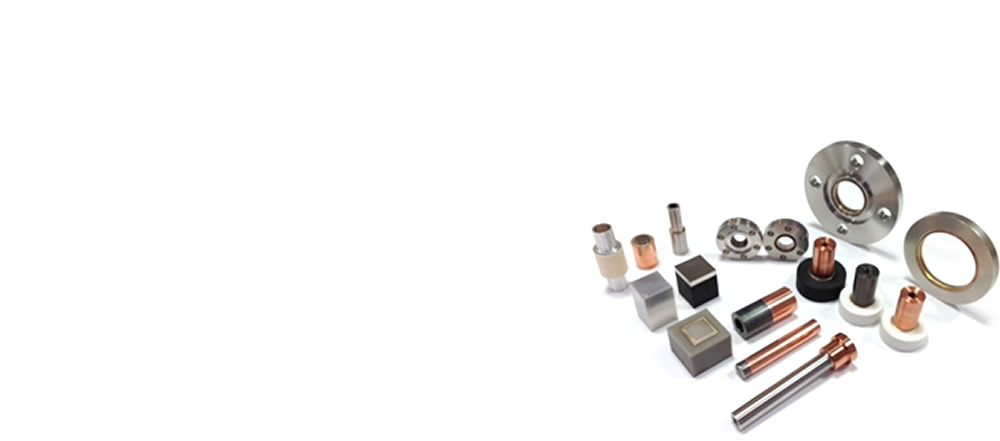
Research and Development

To soundly join the metal materials and new materials such as ceramics, graphite, non-metallic materials, etc. you need to consider two join conditions. One is that whether it appropriately reacted between the materials or not and the other is that whether it is occurred one of the other cracks in new materials which often have a brittleness in the thermal stress. We confirm the existence of a reaction of the joint and the possibility of cracking due to thermal stress.
We conduct a prototype test and investigate if the reaction product is made as intended by electron microscopy and EPMA. Furthermore, we verify that it is joined accurately with airtightness test and joint strength tests. This process makes design/development/manage quick and speedily, and we have been continued to make the reliable joint by accumulated data with repeating the analysis and verification.
In the development of the joining method of New materials such as ceramics , graphite , non-metallic materials, etc., we mainly conduct joining with metallizing method that metallize new material surface thinly and does not cause a large external pressure and heat load on new material surface because these materials contain brittle materials.
It should be noted that, depending on the type of new materials we directly join each materials without using the metallizing method. In this case, we perform the extraction of the joining method by analysis the reaction between the new materials and the brazing materials.
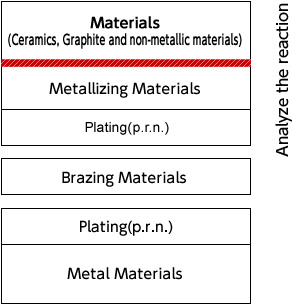
Calculate the standard free energy change (ΔG0)
We analyze the reaction of the subject using based on the law of Hess the ΔH0298,S0298. When ΔG0 of reaction formula is negative, the reaction is satisfied
The selection of the metallizing material composition
please refer to the formula and figure of composition selection example.
Kawaso Texcel’s metallizing method is conducted by using Ti, as metallization material composition. It make a metal layer by melting Ti and mixed powder of other metals on the new material surface. We call this method “Melting Titanum metallizing” and have a lot of practical experience.
Melting Ti will achieve strong joining to produce a reaction product shown below at the interface between the new material.
Al2O3, Sapphire ⇒ TiOx Si3N4, AlN ⇒ TiN
SiC, Graphite, Diamond ⇒ TiC
Example of metallizing material composition selection
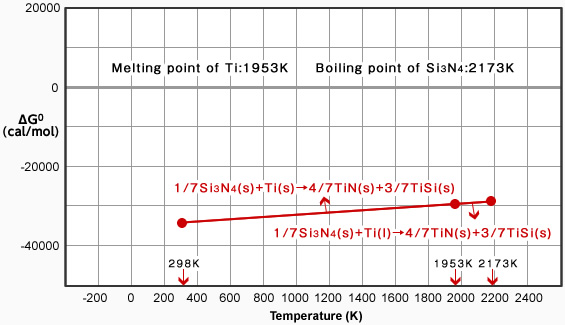
Please refer to the example the case of using Ti as metallizing material composition and Si3N4 as new materials. The right figure shows the reaction formula and the standard free energy change (ΔG0) .
The interface of Si3N4 is expected to be generated TiN by joining. This reaction proceeds has been extensively tested.
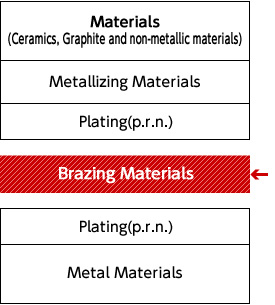
We select a brazing material that rich in metallurgical affinity with the metallizing materials and metal materials. In many cases, we improve the brazing characteristics by plating.
We conduct the deformation analysis and residual stress analysis of the actual joint member (maximum principal stress σ1) by FEM thermal elastic-plastic analysis.
In cases in which there is a risk of large cracking and deformation in the new material, we use the soft material inserted joining method such as the stress relaxation joining, optimizing joint shape and the small thermal load joining.
The following shows the setting guidelines for setting guidelines for residual stress analysis example and crack prevention measures and deformation analysis examples and deformation prevention measures.
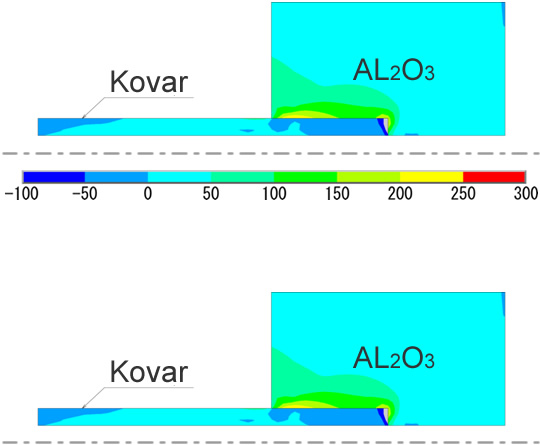
The results of the residual stress through FEM thermal elastic-plastic analysis in mating joint junction of A2O3 tube and Kovar tube shown in the figure below.
The figure is a distribution diagram of the maximum principal stress, which is often used for stress evaluation of brittle materials (σ1).
In comparison the maximum value of the maximum principal stress that occurred during the Al2O3 and (σ1max) and the breaking strength of Al2O3, and predict the cracking.
When the crack is large, risk of developing performs the calculation for the above-mentioned stress relaxation means that corresponds to the product structure. We are setting a valid crack prevention measures.
The results of the deformation analysis was performed simultaneously with the stress analysis by FEM thermal elastic-plastic analysis in mating joint junction of Al2O3 tube and Kovar tube shown in the figure below.
Generally occur in the metal and outputs the deformation diagram of an enlarged several times to the equivalent stress (σe) and then contrast evaluation.
When the amount of deformation is large, we look for the deformation prevention measures in the same way of thinking as the residual stress relaxation method.
For actual member provisionally prototype, first of all, we check whether the crack and deformation prevention measures are working effectively or not with the penetrant inspection and three-dimensional shape measuring instrument. And then, we confirm that there are a predetermined characteristic in joint part through the state analysis and joint strength test with TEM observation, EPMA, X -ray diffraction (XRD), a suitably carried out X-ray photoelectron spectroscopy (XPS).
The following example shows the result of analysis of joint part of Al2O3 and Kovar fittings with electron microscopic observation, EPMA and XPS.
The following example shows the joint interface of Al2O2 and Kovar, that is using Kawaso’s metallizing method in which “melting Ti”,by electron microscopic observation, EPMA, XPS. There are no defects such as voids and micro-cracks, and TiO2 is observed in the Al2O3 surface by the reaction analysis.
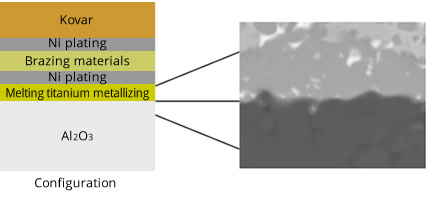
Electron micrograph of the Al2O3 / Kovar junction joints using melting Ti method to metallization
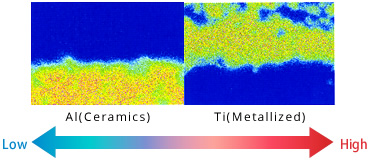
EPMA example of Al2O3 bonding interface of Al2O3 / Kovar junction joints using melting Ti method to metallization
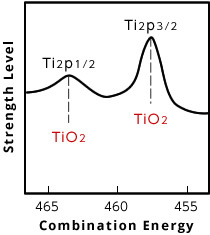
XPS example of Al2O3 bonding interface of Al2O3 / Kovar junction joints using melting Ti method to metallizing(removed the brazing filler metal in acid)
Deformation measurement of the assembly by the three-dimensional shape measuring instrument
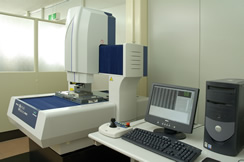
We verify the quality of the joint part and confirm whether the required performance is obtained or not. There are several important characteristics such as leak resistance, electrical resistance, insulation resistance, pressure resistance, and corrosion resistance.
